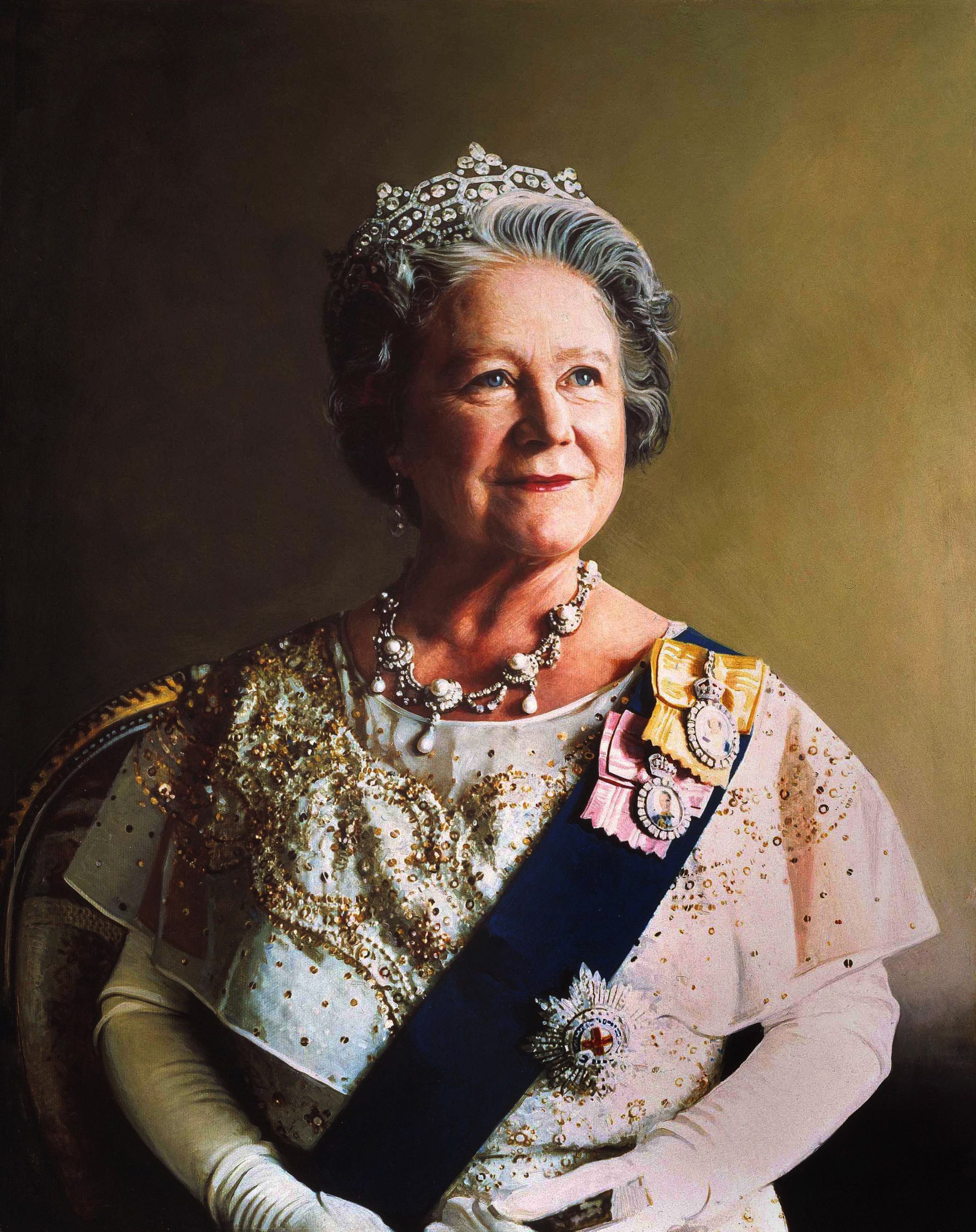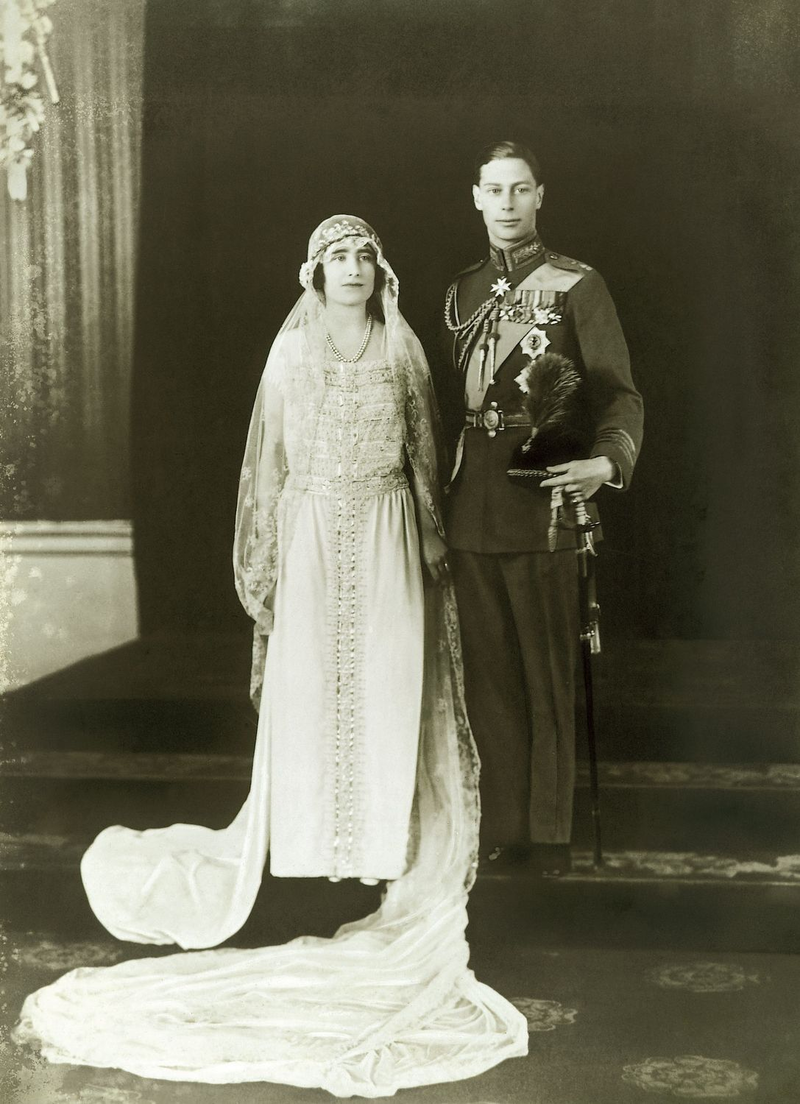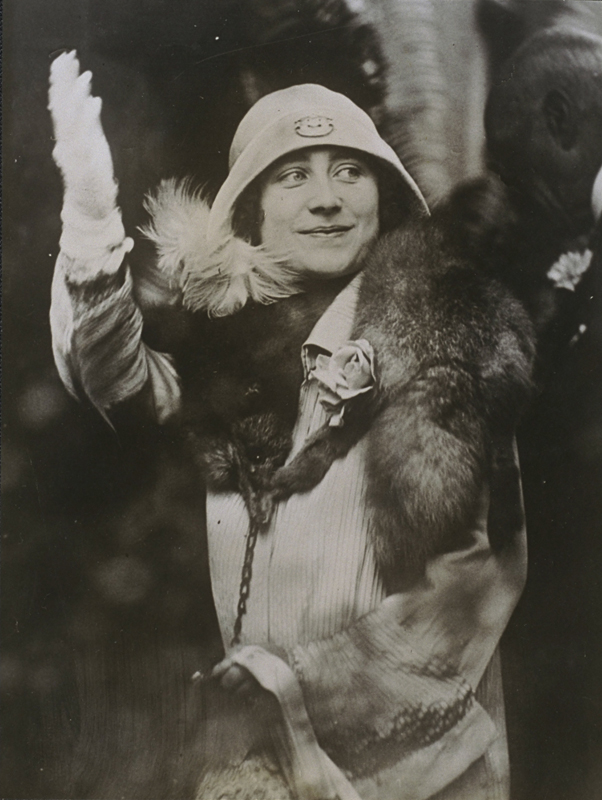by Scott Mehl and Susan Flantzer © Unofficial Royalty 2013

Queen Elizabeth The Queen Mother painted by Richard Stone in 1986; Credit – Wikipedia
On August 4, 1900, The Honorable Elizabeth Angela Marguerite Bowes-Lyon was born, the youngest daughter and ninth child of the ten children of Claude Bowes-Lyon, Lord Glamis (later the 14th and 1st Earl of Strathmore and Kinghorne) and Cecilia Cavendish-Bentinck. The exact place of her birth is unknown. She was alleged to have been born in her parents’ home in London, but her birth was registered at Hitchin, Hertfordshire, near her family’s English country house, St Paul’s Walden Bury, which was also given as her birthplace in the census the following year. The infant Elizabeth was christened on September 23, 1900, at All Saints Church in St Paul’s Walden, the local village. Because the christening records are incomplete, only two godparents are known: Lady Maud Bowes-Lyon (her father’s unmarried sister) and Mrs. Arthur James (the former Venetia Cavendish-Bentinck, her mother’s second cousin). When Elizabeth was four years old, her father became Earl Strathmore and Kinghorne, and her courtesy title was elevated to Lady Elizabeth.
The Bowes-Lyon family is an old Scottish family. King Robert II of Scotland, the first of the House of Stewart, granted Sir John Lyon the Thaneage of Glamis in 1372 as a reward for service. In 1376, Sir John married Joanna, a daughter of Robert II of Scotland. Their grandson Patrick was created Lord Glamis in 1445. The 9th Lord Glamis, also a Patrick, was created Earl of Kinghorne in 1606. His grandson, the 3rd Earl, obtained a charter in 1677 stating that he and his heirs “should in all future ages be styled Earls of Strathmore and Kinghorne, Viscounts Lyon, Barons Glamis, Tannadyce, Sidlaw, and Strathdichtie.” The 9th Earl married a Durham heiress, Mary Eleanor Bowes. As a condition of the marriage settlement, he assumed the surname Bowes. Their sons, the 10th and 11th Earls, and their great-grandson, the 12th Earl, adopted the surname Lyon-Bowes, but the 13th Earl reversed the order to the current Bowes-Lyon.
Elizabeth had nine siblings who were the aunts and uncles of Queen Elizabeth II:
- The Honorable Violet Bowes-Lyon (1882 – 1893), died of diphtheria at age 11
- Lady Mary Bowes-Lyon (1883 – 1961), married Sidney Elphinstone, 16th Lord Elphinstone, had issue
- Patrick Bowes-Lyon, 15th and 2nd Earl of Strathmore and Kinghorne (1884 – 1949), married Lady Dorothy Godolphin-Osborne, had issue including Timothy Bowes-Lyon, 16th and 3rd Earl of Strathmore and Kinghorne
- The Honorable John Bowes-Lyon (1886 – 1930), married The Honorable Fenella Hepburn-Stuart-Forbes-Trefusis, had issue
- The Honorable Alexander Bowes-Lyon (1887 – 1911), unmarried, died from a brain tumor at age 24
- The Honorable Fergus Bowes-Lyon (1889 – 1915), married Lady Christian Dawson-Damer, had issue, killed in the Battle of Loos during World War I. See Unofficial Royalty: Royalty and World War I – September 1915
- Lady Rose Bowes-Lyon (1890 – 1967), married William Leveson-Gower, 4th Earl Granville, had issue
- The Honorable Michael Bowes-Lyon (1893 – 1953), married Elizabeth Cator, had issue, including Michael Bowes-Lyon, 17th Earl of Strathmore and Kinghorne
- The Honorable Sir David Bowes-Lyon (1902 – 1961), married Rachel Clay, had issue
Elizabeth spent much of her childhood at St Paul’s Walden Bury, her family’s English country home, and Glamis Castle, her father’s ancestral home in Scotland. She was educated at home by a governess and developed a fondness for field sports, ponies, and dogs. Her brother David, who was two years younger, was especially close to his sister.
In 1914, on Elizabeth’s 14th birthday, the United Kingdom declared war on Germany. All four of her eldest surviving brothers saw action in World War I. The three elder surviving brothers were already in the British Army: Patrick, John, and Fergus were all in the Black Watch. The next brother, Michael, had just completed his first year at Magdalen College, Oxford, but he volunteered for the Scots Guard at once. Glamis Castle was turned into a convalescent home for wounded soldiers, which the teenage Elizabeth helped to run.
Fergus was sent to the Western Front in 1915, where the British Army and the French Army were attacking the German lines in Champagne and Artois in France to relieve pressure on their Russian allies. On September 27, 1915, during the Battle of Loos, Fergus was ordered to remove a group of Germans who had infiltrated a trench by the Hohenzollern Redoubt, a defensive strongpoint of the German 6th Army, which the Black Watch had captured on September 26. Fergus and his men had been fighting continuously for the previous two days and nights. They had been relieved at 4 AM on September 27 and were preparing breakfast when the new orders were received. Fergus led his men forward, but a German bomb exploded at his feet. His right leg was blown off, and he suffered chest wounds. At the same time, bullets hit him in the chest and shoulder. Fergus was removed from the battlefield and died a few hours later at the age of 26.
At the time of Fergus’ death, his brother John was also serving with the Black Watch. His younger brother Michael was at home recovering from wounds, and his eldest brother Patrick had recently left the Black Watch after being wounded. His mother was severely affected by the loss of her son. After his death, she became an invalid and withdrew from public life until the marriage of Elizabeth to the future King George VI in 1923.
In 1916, Elizabeth had been introduced to the second son of King George V, Prince Albert, known as Bertie, at a tea party. The two had first met in 1905 at a children’s party, but neither recalled that meeting. Bertie, who was created Duke of York in June 1920, and Elizabeth had their first significant meeting on July 8, 1920, at the Royal Air Force Ball at the Ritz in London. Bertie had come to the ball with his equerry The Honorable James Stuart (the future 1st Viscount Stuart of Findhorn), the youngest son of the 17th Earl of Moray. Elizabeth and James were old friends from Scotland and shared a dance. Bertie questioned James about his dance partner and asked to be introduced. Although the meeting did not make much of an impression on Elizabeth, Bertie fell in love that evening and started courting Elizabeth.
Bertie first proposed to Elizabeth in 1921, but was rejected because Elizabeth feared the changes in her life as a member of the Royal Family would require. Elizabeth served as a bridesmaid at the wedding of Bertie’s sister Mary, Princess Royal in February 1922. The following month, Bertie again proposed to her and once more, was turned down. On January 2, 1923, after taking Elizabeth to dinner at Claridge’s and the theater, Bertie proposed a third time. After talking to friends and relatives and expressing her feelings in her diary, Elizabeth decided on January 14, 1923, to accept Bertie’s proposal, although she still had misgivings. The wedding of The Duke of York and Lady Elizabeth Bowes-Lyon was held on April 26, 1923, at Westminster Abbey, London. As Elizabeth was proceeding down the aisle, she passed the Tomb of the Unknown Warrior, whose remains had been brought from France and buried in the Abbey floor three years earlier. Elizabeth laid her bouquet of white roses on it. No doubt she was thinking of her brother Fergus and all the other British soldiers who died in World War I.

Prince Albert, Duke of York (future King George VI) and Lady Elizabeth Bowes-Lyon on their wedding day; Credit – Wikipedia
The couple had two daughters:
- Queen Elizabeth II (1926 – 2022), married Prince Philip of Greece and Denmark, created Duke of Edinburgh, had three sons and one daughter
- Princess Margaret (1930 – 2002), married and divorced Antony Armstrong-Jones, created 1st Earl of Snowdon, had one son and one daughter
The Duke and Duchess of York took up residence at 145 Piccadilly in London and threw themselves into royal duty. They made a successful visit to Northern Ireland in July 1924 and toured East Africa from December 1924 to April 1925. Bertie had a stammer, which affected his ability to deliver speeches, and starting in October 1925, Elizabeth assisted him with the therapy devised by Lionel Logue, portrayed in the 2010 film The King’s Speech. In 1927, a year after their first child was born, Bertie and Elizabeth took a long tour by sea on behalf of King George V via the Atlantic Ocean to Jamaica, the Panama Canal, and the Pacific Ocean to Australia, New Zealand, and Fiji. Elizabeth, in her own words, was “very miserable at leaving the baby”.

Elizabeth in Sydney, Australia in 1927; Credit – Wikipedia
By 1930, the couple’s two daughters had been born. The family enjoyed a rather quiet life, aside from the Duke and Duchess’ royal duties. However, their situation would soon change. On January 20, 1936, King George V passed away at Sandringham. Bertie’s elder brother became King Edward VIII, and Bertie became heir-presumptive to the throne. The new king was unmarried and involved with Wallis Simpson, a twice-divorced American. This relationship would soon bring about unheard-of events in the British monarchy. Failing to reach an agreement with the Government to marry Mrs. Simpson, King Edward VIII abdicated on December 11, 1936, giving his famous “without the woman I love” speech on the radio. Upon Parliament’s passing of the Abdication Act, Bertie became the new King of the United Kingdom, taking the regnal name George VI, in honor of his father, and to stress the continuity of the British monarchy. Bertie and Elizabeth’s coronation took place on May 12, 1937, at Westminster Abbey.
Bertie and Elizabeth worked to restore the monarchy’s reputation after the abdication, and presented a united front along with their two daughters. They would face World War II without fleeing their country as many other monarchs did. Instead, they continued to be seen and toured war-damaged areas. While their daughters were safely in residence at Windsor Castle, Bertie and Elizabeth would continue working daily at Buckingham Palace. When it was suggested that the royal family leave the country for their safety during The Blitz, Elizabeth said, “The children will not leave unless I do. I shall not leave unless their father does, and the king will not leave the country in any manner whatever.” During the Blitz, Buckingham Palace and its grounds were bombed on sixteen separate occasions, nine of which were direct hits. Elizabeth felt solidarity with other Londoners who had been bombed, particularly the East End, when she said, “I’m glad we have been bombed. I feel I can look the East End in the face.”
After the war, their elder daughter Princess Elizabeth married Lieutenant Philip Mountbatten (formerly Prince Philippos of Greece), and two of their four children were born, Charles in 1948 and Anne in 1950. On February 6, 1952, Bertie passed away at just 56 years old, and his 25-year-old elder daughter became Queen Elizabeth II. Not liking the title Queen Dowager, and not wanting to be confused with her daughter, Elizabeth took on the title of Queen Elizabeth The Queen Mother. Devastated by the loss of her husband, The Queen Mother shied away from public duties for some time, until Winston Churchill convinced her that she was just as needed as always. She began to take on royal duties and appearances again. For the next 50 years, Queen Elizabeth The Queen Mother would be one of the most beloved members of the Royal Family and was particularly close to her eldest grandchild, Charles.
On March 30, 2002, less than a month after the death of her younger daughter Princess Margaret, The Queen Mother passed away at Royal Lodge, her home in Windsor Great Park. Her daughter Queen Elizabeth II and two of her grandchildren, the children of Princess Margaret, David Armstrong-Jones, 2nd Earl of Snowdon, and his sister Lady Sarah Chatto, were with her. At the time, she was the longest-lived member of the British Royal Family at age 101. For The Queen Mother’s lying-in-state at Westminster Hall, her four grandsons, the Prince of Wales (now King Charles III), the Duke of York, the Earl of Wessex, (now the Duke of Edninburgh) and Viscount Linley (now 2nd Earl of Snowdon) stood guard, repeating what the four sons of King George V did at his lying-in-state in 1936.
After a funeral at Westminster Abbey, Queen Elizabeth The Queen Mother was buried in the George VI Chapel at St George’s Chapel, Windsor Castle, beside her husband and the ashes of her daughter Margaret, and where her son-in-law Prince Philip, The Duke of Edinburgh and daughter Queen Elizabeth II were later buried.
- Wikipedia: Funeral of Queen Elizabeth The Queen Mother
- Unofficial Royalty: March 30, 2002 – Death of Queen Elizabeth The Queen Mother
- Unofficial Royalty: In Memoriam – Queen Elizabeth The Queen Mother (1900-2002)

King George VI Memorial Chapel; Credit – The Royal Family Facebook page
This article is the intellectual property of Unofficial Royalty and is NOT TO BE COPIED, EDITED, OR POSTED IN ANY FORM ON ANOTHER WEBSITE under any circumstances. It is permissible to use a link that directs to Unofficial Royalty.
United Kingdom Resources at Unofficial Royalty
- United Kingdom of Great Britain and Northern Ireland Index
- House of Windsor Index
- Birth of the House of Windsor
- British Royal Weddings
- Children, Grandchildren, Great-Grandchildren, and Great-Great-Grandchildren of King George V
- Coronations after the Norman Conquest (1066 – present)
- History and Traditions: Windsor Weddings Part 1 – Children of King George V
- History and Traditions: Windsor Weddings Part 2 – Later Windsor Weddings
- House of Windsor Christenings
- House of Saxe-Coburg and Gotha and House of Windsor Burial Sites
- Line of Succession to the British Throne
- Windsor Weddings Part 1 – Children of King George V
- Windsor Weddings Part 2 – Later Windsor Weddings
- When The British Monarch Dies
Works Cited
- “King George VI Of The United Kingdom”. Unofficial Royalty. N.p., 2017. Web. 26 Mar. 2017.
- Longford, Elizabeth. The Queen. 1st ed. New York: Knopf, 1983. Print.
- “March 30, 2002 – Death Of Queen Elizabeth The Queen Mother”. Unofficial Royalty. N.p., 2017. Web. 26 Mar. 2017.
- “Queen Elizabeth The Queen Mother”. En.wikipedia.org. N.p., 2017. Web. 26 Mar. 2017.
- Shawcross, William. Queen Elizabeth. 1st ed. London: Pan Books, 2010. Print.
- “Wedding Of George VI And Lady Elizabeth Bowes-Lyon”. Unofficial Royalty. N.p., 2017. Web. 26 Mar. 2017.
- Williamson, David. Brewer’s British Royalty. London: Cassell, 1996. Print.
